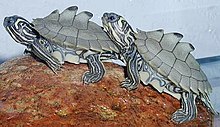Black-knobbed map turtle
| Black-knobbed map turtle | |
|---|---|
 |
|
| Black-knobbed map turtle hatchlings | |
| Scientific classification | |
| Kingdom: | Animalia |
| Phylum: | Chordata |
| Subphylum: | Vertebrata |
| Class: | Reptilia |
| Order: | Testudines |
| Family: | Emydidae |
| Subfamily: | Deirochelyinae |
| Genus: | Graptemys |
| Species: | G. nigrinoda |
| Binomial name | |
|
Graptemys nigrinoda Cagle, 1954 |
|
| Subspecies | |
|
|
 |
|
| Range map | |
| Synonyms | |
|
|
The black-knobbed map turtle (Graptemys nigrinoda), formerly known as the black-knobbed sawback, is a small to medium-sized aquatic turtle with light gray skin. Some of the most distinguishing characteristics of the black-knobbed map turtle, and the Graptemys genus, are the protruding “spikes” on the turtle’s carapace. This species inhabits mainly the fall lines of rivers in the Mobile Bay drainage, in Alabama and Mississippi.
The carapace of G. nigrinoda is slightly domed with the first four vertebrae possessing backward-projecting, knob-like processes, which are black in color. The second and third processes are more dominant in size compared to the first and fourth. With aging females, the knobs are reduced to small swellings.
The carapace is dark olive-brown in color. Within each pleural, or "plate", of the shell are yellow-green circular rings which are outlined in black.Hatchlings are similar in color to adults, but the colors tend to be more vibrant and contrasting. The knob-like processes are compressed laterally.
The head is small, and is dark brown with yellow stripes, with yellow crescents behind the eye facing towards the posterior end of the turtle. These stripes continue on the legs of the turtle also, with the underside of the leg being lighter than the dorsal surface.
Sexual dimorphism is evident in this species. Females are roughly twice the size of males. Also, females’ carapaces tend to be higher than those of males, though the males have longer tails than the females. Sizes (carapace lengths) have been recorded as ranging from 7.6-10.2 cm (3–4 in) in males and 10.2-19.1 cm (4-7.5 in) in females.
The black-knobbed map turtle is endemic to the southeastern United States. In Alabama, they are found in the Mobile Bay drainage. In Mississippi, they are found in the Tombigbee River system and in the Black Warrior River as far north as Jefferson County, Alabama. They are only able to survive in fresh water, thus they are only found within freshwater river systems.
...
Wikipedia

